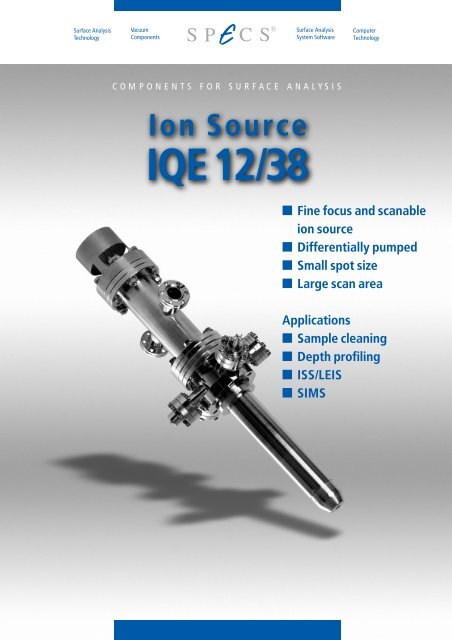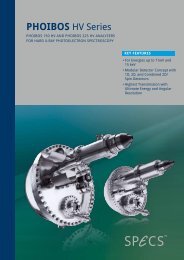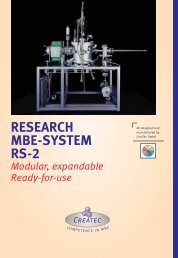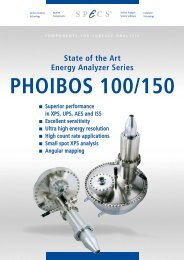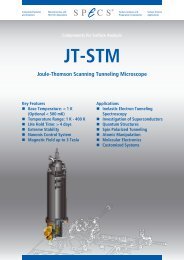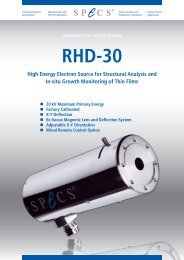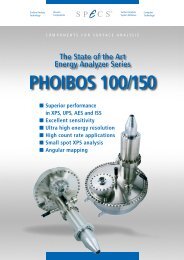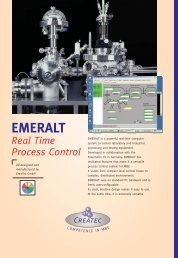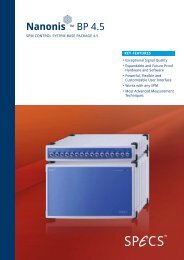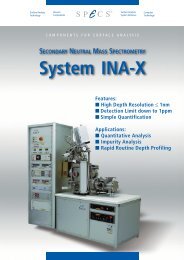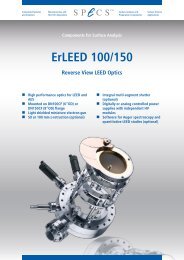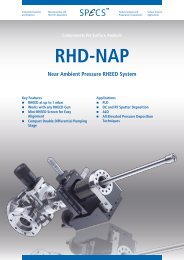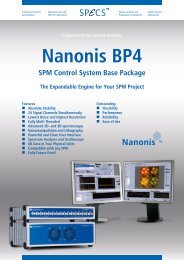IQE 12/38 - SPECS Surface Nano Analysis GmbH
IQE 12/38 - SPECS Surface Nano Analysis GmbH
IQE 12/38 - SPECS Surface Nano Analysis GmbH
Create successful ePaper yourself
Turn your PDF publications into a flip-book with our unique Google optimized e-Paper software.
<strong>Surface</strong> <strong>Analysis</strong><br />
Technology<br />
Vacuum<br />
Components<br />
<strong>Surface</strong> <strong>Analysis</strong><br />
System Software<br />
Computer<br />
Technology<br />
COMPONENTS FOR SURFACE ANALYSIS<br />
Ion Source<br />
<strong>IQE</strong> <strong>12</strong>/<strong>38</strong><br />
■ Fine focus and scanable<br />
ion source<br />
■ Differentially pumped<br />
■ Small spot size<br />
■ Large scan area<br />
Applications<br />
■ Sample cleaning<br />
■ Depth profiling<br />
■ ISS/LEIS<br />
■ SIMS
IEQ <strong>12</strong>/<strong>38</strong><br />
Features<br />
The <strong>IQE</strong> <strong>12</strong>/<strong>38</strong> is an extractor type ion source, mounted<br />
on a rotatable DN<strong>38</strong>CF (2 3/4” O.D.) flange.<br />
At its standard flange-to-sample distance of 186 mm,<br />
which corresponds to a working distance of 23 mm,<br />
it generates a beam current up to 0.8 µA at a spot size<br />
of <strong>12</strong>5 µm.<br />
The two lens system of the source allows easy<br />
changing of the spot size, which is continuously<br />
variable from <strong>12</strong>5 µm to 1000 µm. For a spot size of<br />
800 µm the ion current is up to 8 µA. The corresponding<br />
current density is 1-4 mA/cm 2 depending on the<br />
spot size.<br />
This performance data has been proven in the field<br />
and can be considered as conservative. Operation of<br />
the <strong>IQE</strong> <strong>12</strong>/<strong>38</strong> at larger flange-to-sample distances<br />
(with a correspondingly larger exit aperture-to-sample<br />
distance ) still provides satisfactory performance.<br />
It can be operated over a primary energy range of 0.2<br />
to 5 keV. Because of its very slim outline and a housing<br />
cone angle of 50° it is ideally suitable for tight environments.<br />
The filament is non-line-of-sight to the sample, thereby<br />
minimizing contamination from the source. It is<br />
field replacable with non-critical alignment and long<br />
lifetime which makes the source serviceable by the<br />
user and hence economical.<br />
Due to this special cathode type (Y 2 O 3 coated Ir filament)<br />
the operation temperature of the ionizer is considerably<br />
lower than for other sources, hence reducing<br />
ion beam contamination. Additionally the cathode<br />
allows therefore operation with reactive gases like<br />
O 2 , H 2 and hydrocarbons. Argon is normally used as<br />
the operating gas, while Oxygen for example is used<br />
for shallow implantation studies and SIMS applications,<br />
giving enhanced sensitivity.<br />
The scanned area is 10 x 10 mm 2 at the standard<br />
working distance of 23 mm. Over this area the sputter<br />
crater is extremely flat. This results in precise depth<br />
profiles with maximum depth resolution.<br />
There are two ports for differential pumping. Usually<br />
the first differential pumping stage is linked with the<br />
pumping line of the second differential stage via a<br />
valve acting as a throttle. The second differential<br />
stage is connected to a UHV pumping system. This<br />
way the pressure in the analysis chamber can be maintained<br />
in the 10 -8 mbar range while the source is operating<br />
at the specified maximum beam current .<br />
The source can be supplied complete with an UHV gas<br />
inlet with leak valve and a differential pumping system.<br />
As an option an additional Wien Mass Filter can<br />
be retrofitted to the source.<br />
Further details at www.specs.de<br />
Beam Profile<br />
Fine Focus Mode<br />
High Current Mode<br />
Operation Conditions<br />
gas/pressure: Ar/ 9.8 x 10 -7 mbar<br />
working distance: 23 mm<br />
emission current: 10 mA<br />
energy: 5 keV<br />
total sample current: 1.006 µA<br />
Operation Conditions<br />
gas/pressure: Ar/ 4.0 x 10 -7 mbar<br />
working distance: 23 mm<br />
emission current: 10 mA<br />
energy: 5 keV<br />
total sample current: 9.2 µA<br />
C o m p e t e n c e i n S u r f a c e A n a l y s i s
IEQ <strong>12</strong>/<strong>38</strong><br />
Performance<br />
Ion beam current<br />
Sputter Rate<br />
The fine focus mode is commonly used for XPS<br />
and AES depth profiling. A typical set of parameters<br />
for this application is 1 µA ion current, 150 µm beam<br />
diameter and 5 keV ion energy with Argon as the<br />
process gas. For a Ag surface this gives a sputter rate<br />
of about 50 Monolayer/s.<br />
If the beam is scanned over an area of 10 x 10 mm 2<br />
the resulting sputter velocity is reduced by<br />
a factor of about 10 4 .<br />
Ion energy [keV]<br />
Applications<br />
Depth Profiling<br />
Example: 100 nm SiO 2 layer on Si wafer;<br />
(standard sample for depth calibration)<br />
Performance Curve<br />
Ar + -ion beam current<br />
at various energies and<br />
constant beam diameters<br />
(FWHM)<br />
LEIS/ISS<br />
Example: Revealing the catalytically active site<br />
in a Spinel Oxide Powder ZnAl 2 O 3<br />
Elementary layer compositions and depth profiles<br />
measured with XPS with the <strong>SPECS</strong> compact ESCA<br />
system SAGE 150.<br />
Shown is the atomic concentration for Silicon and<br />
Oxygen elements calculated from the XPS intensity<br />
of the Si 2p and the O 1s element lines.<br />
The interface between the SiO 2 layer and the Si wafer<br />
substrate is visible as a sharp edge. With a width<br />
of 7 nm (20 % to 80 %).<br />
Spinel surfaces can widely be found in heterogeneous<br />
catalysis. Spinels have the general formula AB 2 O 4 ,<br />
where in a normal spinel the A atoms are tetrahedrally<br />
coordinated, while the B atoms are octahedrally<br />
coordinated. LEIS measurements revealed that only<br />
the B cations were exposed to the surface which<br />
correlated directly to the catalytic activity.<br />
With kind permisson of :<br />
Calipso · LEIS Expertise Center · www. calipso.nl<br />
C o m p e t e n c e i n S u r f a c e A n a l y s i s
IEQ <strong>12</strong>/<strong>38</strong><br />
Technical Data<br />
Ion beam performance<br />
■ Ion beam current: ≥ 0.8 µA in a <strong>12</strong>5 µm spot;<br />
≥ 8 µA in a 800 µm spot (at 5 keV, Ar + )<br />
■ Two lens system for easy adjustment of spot size<br />
■ High current density, 1-4 mA/cm 2<br />
■ Variable primary energy, 0.2-5 keV<br />
Scanning performance<br />
■ Large scan area, 10 x 10 mm 2<br />
■ Key stone correction of scan area for tilted samples<br />
Dimensional Drawing<br />
Mounting details<br />
■ Large working distance:<br />
23 mm to 100 mm<br />
■ Small cone angle of 50°:<br />
fits almost everywhere<br />
■ DN<strong>38</strong>CF (2 3/4“ OD)<br />
rotatable<br />
base flange<br />
Operation conditions<br />
■ Differential pumping<br />
■ Working pressure down to 10 -8 mbar range<br />
■ Suitable for reactive gases like Oxygen<br />
Options<br />
■ Wien Mass Filter<br />
■ Gas inlet system<br />
■ Differential pumping system<br />
■ Remote operation for depth profiling<br />
<strong>SPECS</strong> reserves the right to alter technical specification without further notice.<br />
Power Supply<br />
PU-<strong>IQE</strong> <strong>12</strong>/<strong>38</strong><br />
■ One housing for power supply and deflection unit, hight<br />
13 cm, fully CPU controlled<br />
■ IEC 488 and RS232 interfaces for remote operation<br />
■ Storage of up to 9 different parameter sets for different<br />
gases or different experimental conditions<br />
■ Key stone correction of scan area for tilted samples,<br />
to generate flat crater bottoms<br />
■ Gating for depth profiling<br />
■ x-y analog monitor voltage outputs (0-10V) for mapping<br />
■ Optional x-y analog<br />
input for operation with external scan generator<br />
■ Setup for geometrical installation conditions<br />
and mechanical dimensions of the source<br />
■ Timer for stand alone operation<br />
■ Fully digitized emission current regulation<br />
for extreme reliability<br />
■ Automatic self test during initialization<br />
■ Check of filament function during operation<br />
■ Constant scanned area over the whole ion energy range<br />
<strong>SPECS</strong> <strong>GmbH</strong> - <strong>Surface</strong> <strong>Analysis</strong><br />
and Computer Technology<br />
Voltastrasse 5, 13355 Berlin<br />
Germany<br />
ISO 9001<br />
Certificate<br />
Your Representative:<br />
Tel.: +49 30 467824 - 0<br />
Fax: +49 30 4642083<br />
E-mail: support@specs.de<br />
http://www.specs.de<br />
C o m p e t e n c e i n S u r f a c e A n a l y s i s


